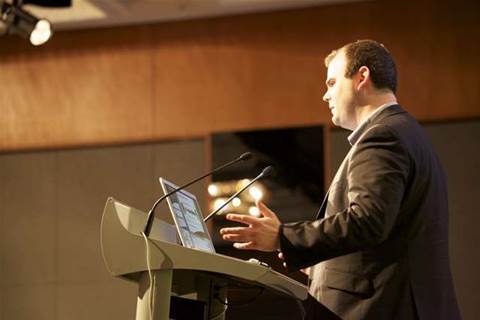Better YouTube uploads
But in a preview of a future to send shivers down the collective spine of entrenched pay TV providers, Sykes outlined plans for multicast transmission over the NBN that would open innovative video services to new players.

Tom Sykes stands in front of a slide that shows expected higher upload speeds on the new broadband network. photo: Nate Cochrane
He said NBN Co was well along in its discussions with new video entrants such as ISPs and expected to make announcements soon.
Video would fuel the broadband revolution, he said, especially for those who wanted to upload to YouTube and Flickr high-definition streams.
And providers would be able to more easily determine the traffic allocated to video, and other applications and devices used by their customers, he said.
"A key part is enabling video transmission. We've had quite a lot of time with some key service providers and multicast [to enable video transmission] was an area of focus and we put quite a bit of work into that."
With ADSL, the upload speed was a tiny function of the download maximum. Even those on ADSL2+ 24Mbps nominal download speeds realistically only got about 2Mbps upload speeds, hindering their ability to share content and be productive.
NBN Co didn't want to fall into such a trap, Sykes said, and was aiming for peak upload speeds far closer to download speeds (see photo above).
For instance, someone with a 100Mbps service at launch should be guaranteed a peak or "burstable" rate of 40Mbps upload speed, he said. And those who progressed to 1Gbps would get 400Mbps uploads. There was the potential for even faster, guaranteed rates depending on the application, NBN Co product documents state.
"One of the things we argued for fairly early is not constraining ourselves to the 10:1 DSL ratio," he said, referring to the faster download speeds that came at the cost of slower uploads.
"Even on YouTube and Flickr right now where you're trying to upload hundreds of [megabytes], we think this will go a long way to helping that.
"We're not artificially constraining the network to a low upstream."
It would be up to the retailer to decide how they assembled and marketed their products, he said, so home users or small businesses could affordably buy a plan with fast upload speeds for sharing multimedia content or productivity gains.
"How you structure that is completely up to you guys [broadband retailers]."
"Jet packs" cling to the wall
Sykes also revealed the network would be composed of catchment areas of up to 75,000 premises called "connectivity serving areas", roughly analogous to DSLAMs installed in phone exchanges that clustered ADSL customers today.

Tom Sykes reveals NBN network termination unit (external) to connect homes and businesses to the high-speed network. photo: Nate Cochrane
"Think of it as an invisible fence around a number of end-user premises," he said.
Each area would be "parented to a point of interconnect" to the rest of the network and service providers, he said. Further, service providers would have the freedom to determine different levels of services for their customers, such as for businesses and homes, he said.
"By selling the product as a component-based arrangement, it's a lot more flexible," he said. "[Service providers] can really structure this according to applications and market segment."
But most retail customers would likely only see the "network termination unit" component of the NBN -- akin to the residential and business gateways or modems in use on today's networks.
Two types were available for inside and outside the premises, the latter, still in concept, looking like a "jet pack", Sykes said.
"It's really the fibre delivery interface to the customer with a number of Ethernet ports" to plug in a PC or wi-fi access point or "some other type of CPU" or IP phone, Sykes said.
He sought to put to rest any concerns that the network would soon be obsoleted by changes in technology.
"We're abstracting the wholesale service from the technology and network platform below. We think that by selling components rather than end-to-end products it gives a higher degree of flexibility.
"And that product could be arranged in thousands of different ways but it puts that level of differentiation out there that isn't currently available."







_(11).jpg&h=142&w=230&c=1&s=1)




.jpg&w=100&c=1&s=0)
_(8).jpg&w=100&c=1&s=0)









